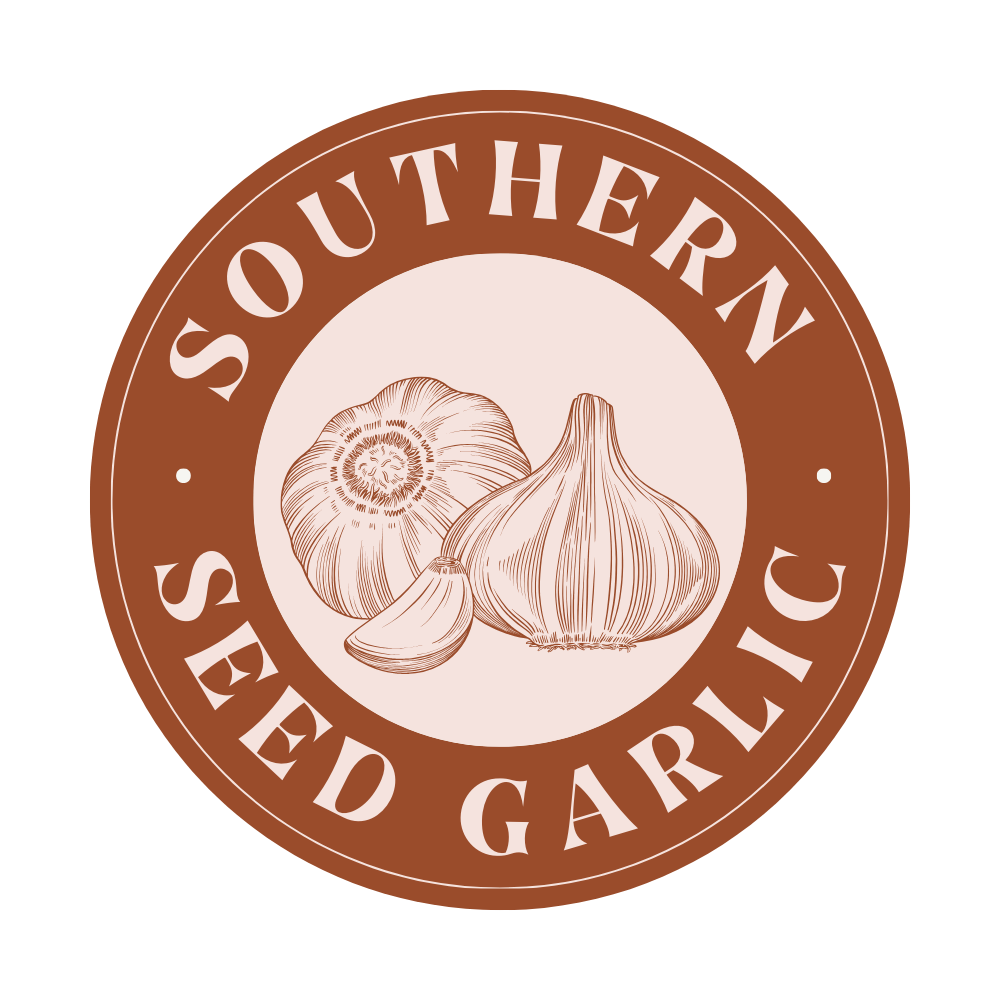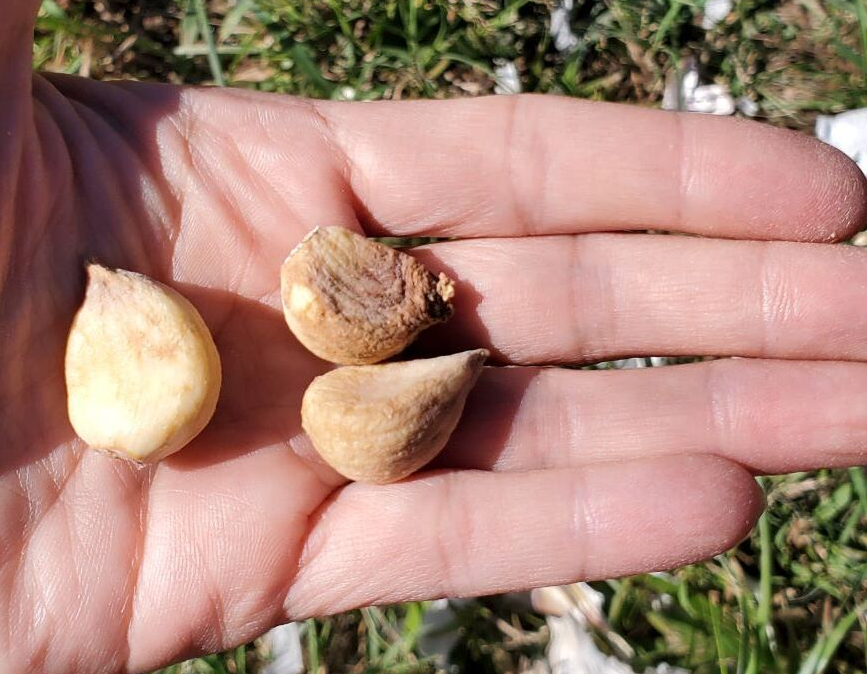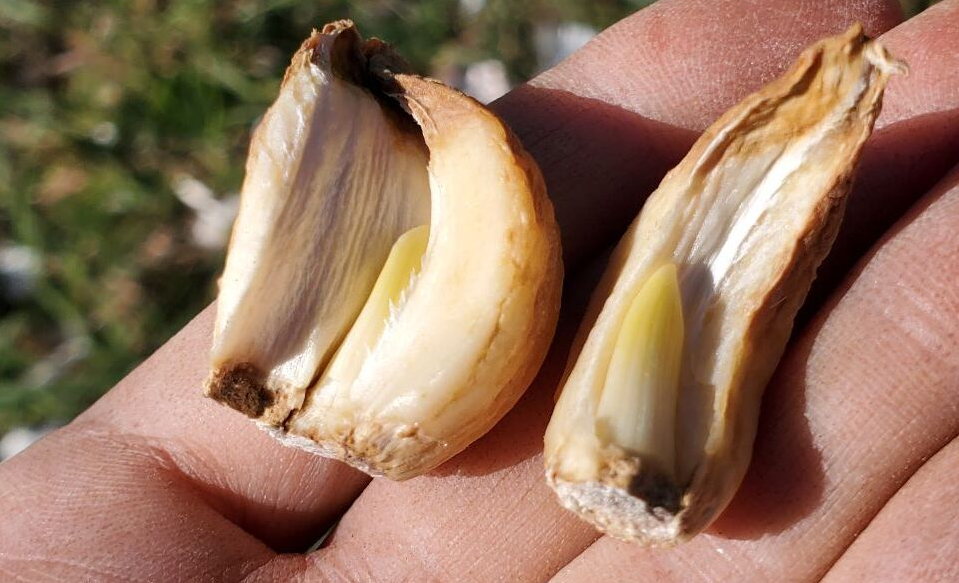Has My Seed Garlic Gone Bad?
How to tell if seed garlic is still viable:
Here at Southern Seed Garlic we inspect our seed garlic at every stage of its journey to insure the best garlic possible, and sincerely hope this is not your experience with our seed! But I have seen this question in online discussions and feel it is a valid one that needs to be addressed. Here are a few things to note when deciding if your garlic seed has gone bad:
★ Sprouting Cloves
★ Diseased Bulbs
★ Mold
Looks Can Be Deceiving
Early in my garlic-growing venture, I ordered a new variety that I was especially excited to try. The bulbs looked great upon arrival; but when I popped out the cloves at planting time, they looked awful! Shriveled, dehydrated, brown..the whole bag didn't appear to have one good bulb left in it. I felt pretty ripped off, since of course it wasn't cheap. I planted a few of the best-looking cloves in hopes they might do something and tossed the rest into the grass. To my surprise, a few weeks later it ALL sprouted! Even the bulbs left down in the tangle of grassroots were cheerfully pushing up their waxy leaves. It was a vivid lesson. The bulbs were beautiful at harvest time, and though by planting time next fall they were again a shriveled mess, this time I put them in the ground with a lot more faith!
First of all, "Garlic Seed" is a misnomer. Garlic is not a seed but a bulb. Like a daffodil or an iris, it is propagated by bulb division and not by producing true seeds. The garlic bulb does not enter dormancy, as a true seed does. A true seed, in the right storage conditions, can last through very many seasons and still grow when planted. I have read of still-viable wheat seeds found in ancient Egyptian tombs. The Egyptians grew garlic, too, but we only know that from their writings!
Inspect Your Cloves
A garlic bulb has actually a very short life: from harvest time in early summer until planting time in the fall. A little time clock is ticking away quickly in that living organism and somehow it knows when fall has come. Not only this, but garlic originated in northern climes, and therefore from an area with a relatively short summer. This means for us gardeners in the south, we have to stretch that time clock to its limits to keep our garlic propagating.
One more factor in this question is the variety. Seed suppliers will often note which varieties are "long-storing". Northern growers may not need to worry about this characteristic, but southern growers should definitely take it into consideration when seed shopping. Curing, weather, and storage conditions will also affect how long any variety stores.
(It should be noted the storage-life limit is the main reason the U.S. imports more garlic...mainly from China...than it exports. The demand is year-round but the locally-produced crop is only viable for a few months of the year. This is a good reason to be growing your own garlic..and to be dehydrating some for garlic powder to tide you over between harvests!)
Now, let's look at some cloves. You take your seed out at planting time, and it doesn't look too palatable. Are the cloves diseased? Will they still grow? What should you do with them?
Sprouting Cloves
First of all, it helps to know a sprouting clove vs. a diseased clove.
A sprouting clove is dried out, soft, often brown, because it is trying to grow! Inside that mysterious living clove something is telling it that autumn has come, and though far-removed from light or temperature differences, it is putting all its energy into trying to reproduce itself.
This is not to advocate, of course, letting your seed get to this point! However, for us southern gardeners who have to wait longer for cool weather to come, we may be faced with this situation occasionally (or regularly with certain varieties). Bulbs in this condition need to be planted immediately if possible. The dehydrating bulb can only support the sprout so long. Without water and light, it will eventually die and decompose. If you open a clove wrapper and find it empty, this is likely what happened.
Diseased Bulbs
What does a diseased bulb look like? Most garlic diseases affect the plant while it is still growing and the well-inspected bulb will never make it to the storage stage if it is diseased. But one disease that can occur in stored bulb is penicillin mold. Never plant bulbs that show any kind of mold on them, as this can infect the plants in the field and lead to crop loss. Immediately discard any moldy bulbs and wash your hands. The cloves pictured here may just be in the last stages of decay rather than hosting penicillin mold, but are an example of what NOT to plant.
Speckled mold
A bulb that resembles the picture here CAN be planted. The spotting is an indication of humid curing conditions, but is not a mold that worsens beyond what is shown here or that affects the cloves themselves.
The reason grocery store garlic is so flawlessly white is that it is often dipped in fungicide. It's pretty, but not natural!
I hope this answers your questions! Grow your own beautiful garlic with our top-performing seed garlic! Garlic is a nutritious and delicious addition to every garden and kitchen. Free Shipping on Every Order!
Want to sell your seed garlic with us?
If you are a seed garlic grower who is looking for a place to market your crop, we are looking for more growers!
We’ve shipped garlic all over America
We’d love to add you to our garlic growers map!





